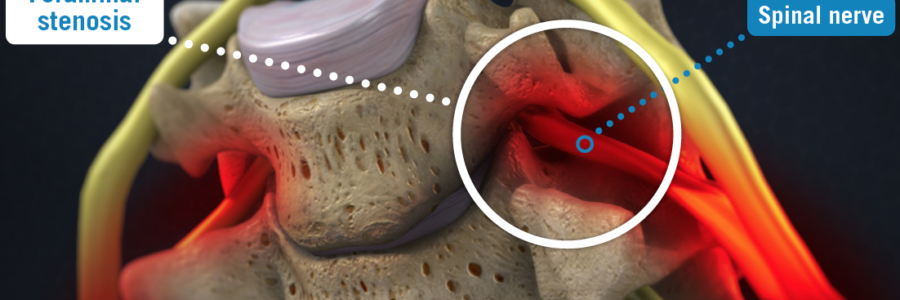
Thoracic foraminal stenosis
In the thoracic spine (mid-back, upper back) foraminal stenosis describes the narrowing of the holes where spinal nerves exit. Bone spurs (wear and tear), disc herniation or a pathological process that affects bone, such as a tumour, can cause thoracic foraminal stenosis.
Most of the risk factors for thoracic foraminal stenosis include those related to ageing and degenerative disease (wear and tear). Some include:
- Excessive body weight
- Older age
- Family medical history (hereditary factors, such as tumours)
- Past injury history (for example, repetitive trauma or infections to the spinal discs)
- Occupation and pastimes (e.g. high-impact sports)
Symptoms
The symptoms of thoracic foraminal stenosis range from nothing to significant pain and dysfunction. It is likely that the intensity of the symptoms will be determined by the amount of narrowing and compression of the thoracic spinal nerves. Pain is common at the level of the nerve compression and down the path of the compressed nerve (dermatome). In some cases, muscle weakness and sensory changes occur.
Treatments
The treatment of thoracic foraminal stenosis is dependent on the amount of narrowing, location of narrowing and severity of symptoms. Chiropractic treatment is useful in this condition. Please see your medical doctor or chiropractor for more information.
More information
Please visit our website for more articles and blogs relating to spinal degeneration:
- Thoracic myelopathy
- Thoracic osteophytes
- Thoracic spine stenosis
- Thoracic degenerative disc disease
- Thoracic arthritis
- Thoracic pinched nerve
- Thoracic facet syndrome
- Thoracic facet joint pain
- Thoracic disc bulge
- Thoracic disc protrusion
- Thoracic spondylosis
- Thoracic spondyloarthropathies
- Thoracic radiculopathy
- Thoracic discogenic pain
- Acute mid back pain
- Chronic mid back pain
- Stiff mid back
- Upper back arthritis








